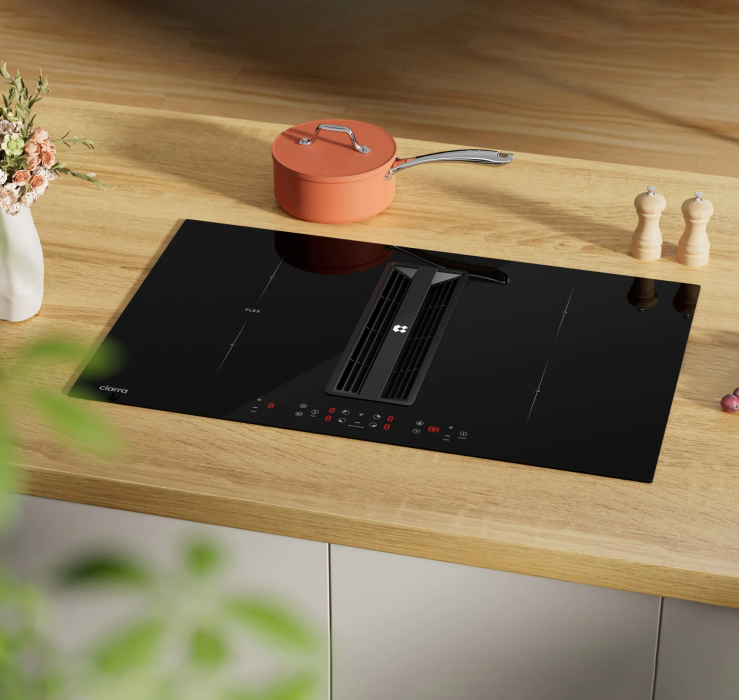In modern kitchen designs, the kitchen island has become more than just a workspace; it often serves as a focal point for cooking and socializing. One of the key challenges in designing an island kitchen is effective ventilation, especially when incorporating a hob or cooktop directly into the island. Here, we explore the importance of venting hobs for kitchen islands and provide a comprehensive guide to help you choose the right one for your kitchen.

Why Venting Hobs Matter
Ventilation is crucial in any kitchen to remove cooking odors, grease, and heat, ensuring a comfortable cooking environment and maintaining indoor air quality. In traditional kitchen layouts, overhead hoods or vent systems are typically installed against a wall above the cooking area. However, in kitchen islands, where the hob is centrally located, there may be other options than traditional ventilation methods.
Venting hobs, also known as downdraft hobs, offer a solution by integrating ventilation directly into the cooking surface. This innovative design pulls smoke, steam, and odors downward through vents located near the burners, either behind or to the sides of the cooktop. This mechanism eliminates the need for an overhead hood, preserving open sightlines and enhancing the aesthetic appeal of your kitchen island.
Key Considerations When Choosing a Venting Hob
- Size and Design Compatibility: Consider the size and design of your kitchen island. Venting hobs come in various widths to accommodate different cooktop sizes. Ensure the dimensions of the hob align with your cooking needs and the overall layout of your island.
- Ventilation Power: The effectiveness of a venting hob depends on its extraction rate, measured in cubic feet per minute (CFM). Higher CFM ratings indicate better ventilation performance. Choose a hob with sufficient CFM to effectively capture and exhaust smoke and odors from your cooking surface.
- Installation Requirements: Installing a venting hob requires careful planning, especially if retrofitting into an existing island. Ensure there is adequate space beneath the island for the ventilation system, including ductwork if needed. Professional installation may be necessary to ensure proper functionality and compliance with building codes.
- Noise Level: Some venting hobs can be noisy, especially at higher extraction speeds. Look for models that offer variable fan speeds or quiet operation modes to minimize noise without compromising performance.
- Maintenance and Cleaning: Consider ease of maintenance when choosing a venting hob. Models with removable filters or dishwasher-safe components simplify cleaning and upkeep, ensuring longevity and efficient operation.
- Aesthetic Appeal: Beyond functionality, the design of the venting hob should complement your kitchen's style. Choose a finish and design that integrates seamlessly with your island countertop and surrounding cabinetry, enhancing the overall visual appeal of your kitchen.
Advantages of Venting Hobs
- Space Efficiency: By integrating ventilation directly into the hob, you free up overhead space, making your kitchen feel more open and spacious.
- Improved Visibility: Unlike overhead hoods that obstruct views, venting hobs provide unobstructed sightlines across the kitchen, allowing for better interaction during cooking and social gatherings.
- Enhanced Cooking Experience: Effective ventilation ensures a cleaner, more comfortable cooking environment, reducing cooking odors and heat buildup in the kitchen.
Installation and Maintenance Tips
- Professional Installation: Hire a qualified professional to install the venting hob, especially if modifications to your kitchen island or ventilation system are required.
- Regular Maintenance: Clean filters and vents regularly to maintain optimal ventilation performance. Follow manufacturer recommendations for care and maintenance to prolong the lifespan of your venting hob.
Conclusion
Choosing a venting hob for your kitchen island involves considering various factors, from size and ventilation power to design compatibility and maintenance requirements. By selecting the right venting hob, you can enhance both the functionality and aesthetics of your kitchen, creating a comfortable and enjoyable cooking space for years to come. Whether you're renovating an existing kitchen or planning a new build, investing in a high-quality venting hob ensures efficient ventilation and seamless integration into your kitchen island design.

